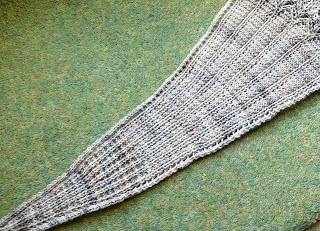I seem to have gained a number of followers recently. Welcome!
I've knitted some lace in my time. Above, the Star Leaves shawl in that glowing autumnal yarn.
The Swallowtail shawl, in a lovely lace-weight yarn.
A Drops design that I knit for a charity some years ago.
These all follow that basic triangular construction of knitting a little garter tab and picking up along its edge to begin at the back neck. The increases therefore come at the predictable places: edges and centre back.
But equally predictable is the lace. With these, once the basic pattern is established, the repeats become obvious from the knitting itself. Like in traditional Fair Isle, the numerical sequences have a balance and a rhythm.
Of course, I learned a few things in knitting these. The Swallowtail uses nupps in its Lily of the valley border, and I had not met those before. The Star Leaves shawl has a section of textured knitting before the leaf section began, which was a puzzle to work out. But, in general, knitting lace, especially on a large shawl, is so repetitive that boredom is a risk to completion. One loses interest before it is finished.
And you can certainly watch television while knitting, although perhaps not read sub-titles.
However, Uncia is different . For a start, there are eight large charts, with the style of openwork constantly changing. Very few of the manoeuvres are completely new, but several of the symbols are unfamiliar. There is a key of course, on each page, and a further explanation of what these mean on two different pages.
Then there are the increases. Because the design is based on the idea of stonework rising in columns, the increases are hidden very cleverly within the ribs. Looking at the finished fabric they are almost invisible. But that also makes them unpredictable on the pattern.
So you sit with the chart, card pinned across above the row one is working, and, reading the row like a line of text, knit the row. By now - I am on Row 350 of 400 - I can mostly predict what to do, and the wrongside rows have become readable from the knitting rather than the chart.
With knitting this complex it would have helped a lot to have a close-up picture of the section to be knit, rather than the series of very beautiful images of the designer, Lucy Hague, wearing it. Then you could see what you were aiming at.
But, as I reach the final chart, I can see that it is also the sort of knitting where you don't want it to be finished. I'll be thinking carefully what my next project will be, to avoid a sense of anti-climax. Lucy Hague has a series of Celtic knotwork shawls, but I'm thinking perhaps Houlland from the "Book of Haps".



















































.JPG)